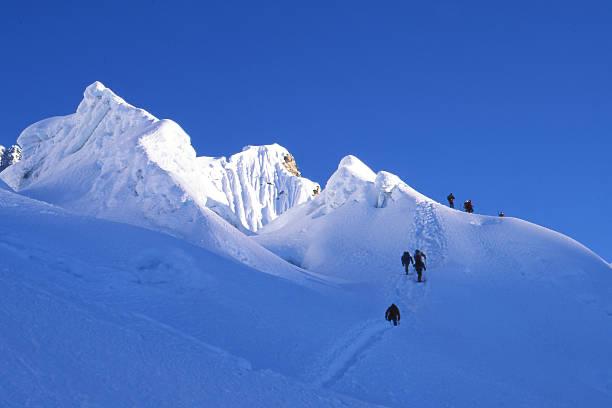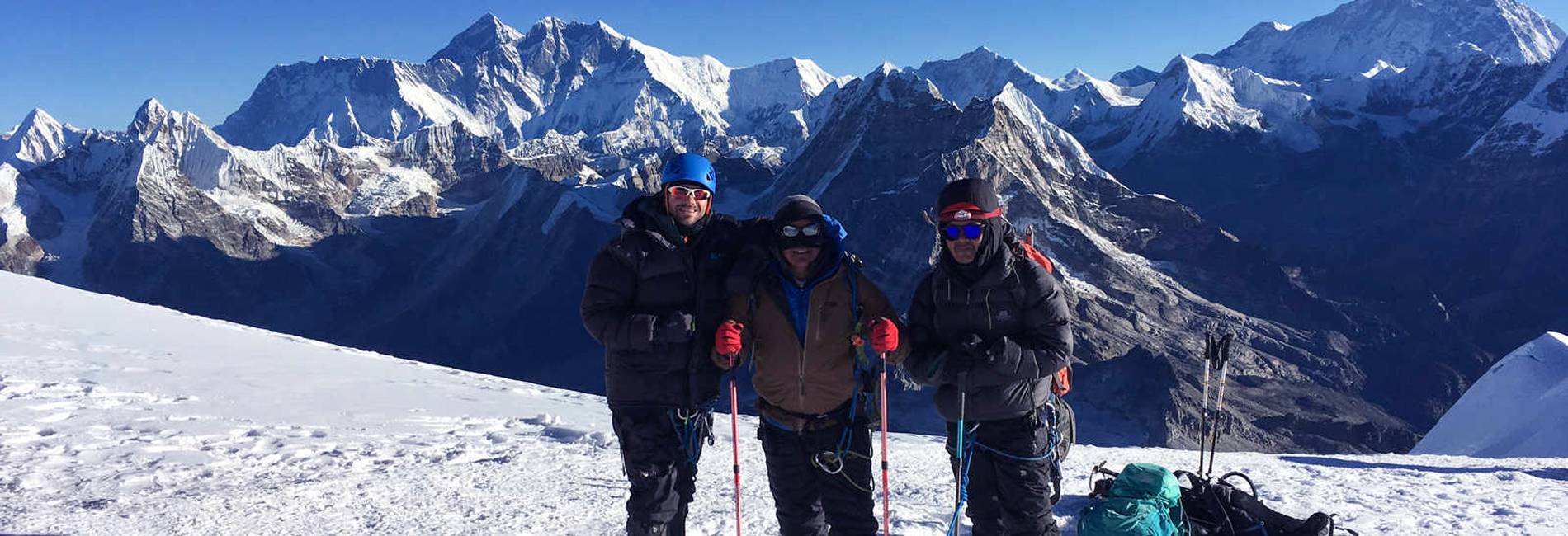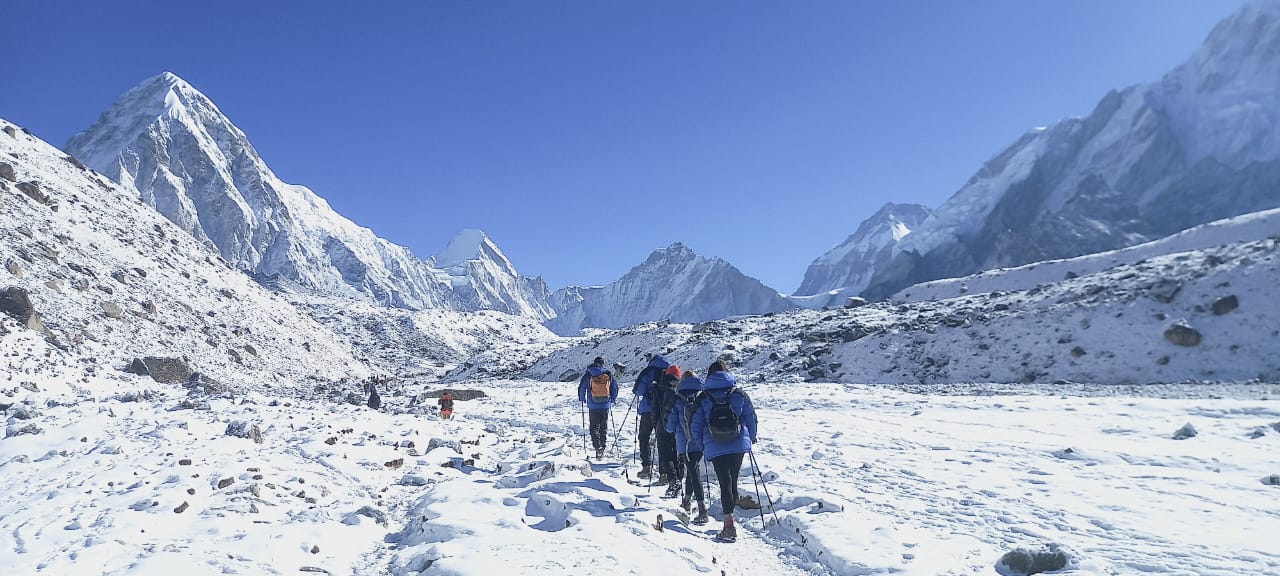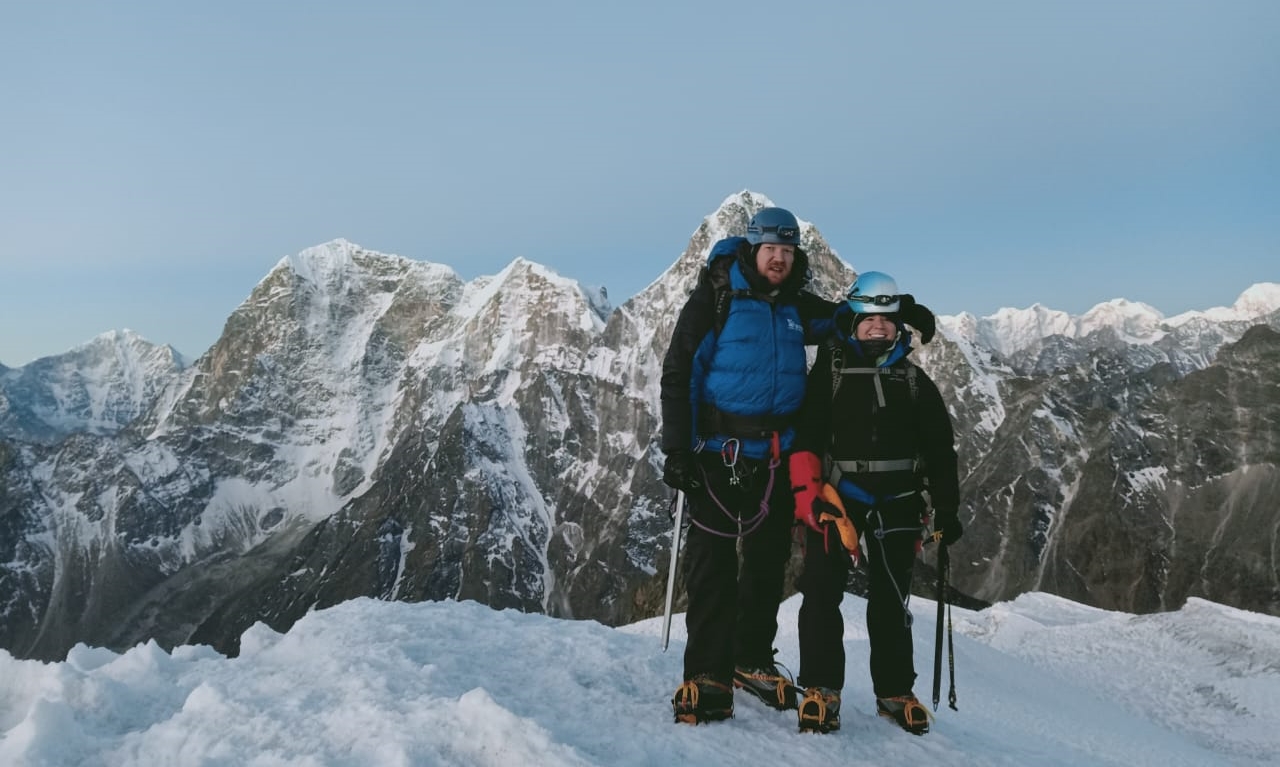26th August, 2025

Jul 26, 2024
Best Time for Mera Peak Climbing
- Overview of Mera Peak Climbing
- Seasonal Weather Patterns in the Himalayas
- Spring Climbing Season: March to May
- Monsoon Season: Challenges and Alternatives
- Autumn Climbing Season: September to November
- Winter Conditions: December to February
- Comparing Spring and Autumn for Climbers
- Recommended Preparations for Each Season
- Conclusion: Choosing Your Ideal Climbing Time
Mera Peak, standing majestically at 6,476 meters, is a sought-after destination for climbers seeking an adventurous challenge in Nepal's Himalayas. Choosing the right time to climb Mera Peak is crucial for a successful and enjoyable ascent, as weather conditions and seasonal variations play a significant role in the experience.
Spring (March to May) is considered one of the prime times for climbing Mera Peak. During this season, the weather is generally stable with moderate temperatures and clearer skies. The temperatures range from -10°C to -5°C at higher altitudes, which are manageable for climbers equipped with proper gear. Spring brings the advantage of witnessing stunning views of snow-capped peaks and enjoying the landscape dotted with blooming rhododendrons and alpine flowers. However, be prepared for potential snowfall and occasional storms, which can add an element of unpredictability to the climb.
Autumn (September to November) is another excellent period for the Mera Peak ascent. The weather during autumn is typically clear and stable, with crisp, cool temperatures ranging from -15°C to -5°C at high altitudes. This season offers spectacular visibility, allowing climbers to enjoy unobstructed views of the Everest region’s towering peaks. The risk of snowstorms and harsh weather is lower compared to spring, making autumn a favored choice for many climbers. The trails are less muddy than in the monsoon season, and the overall climbing conditions are more favorable.

MERA PEAK CLIMBING
Mera Peak Climbing is an exhilarating adventure in Nepal that gives you an opportunity to reach the summit of Mera Peak at more than 6400m above sea level. Actually, it is the highest climbing (w...
Winter (December to February) presents a challenging yet rewarding opportunity for the intrepid climber. Winter transforms the Mera Peak landscape into a serene, snow-covered wonderland, but it comes with significant difficulties. Temperatures at high altitudes can plummet to -20°C or lower, and the risk of avalanches and severe cold increases. Climbers need to be exceptionally well-prepared for extreme conditions and should have experience in high-altitude climbing. Winter climbs offer solitude and a unique perspective of the Himalayas, but the harsh weather requires careful planning and robust equipment.
Monsoon (June to August) is generally considered the least favorable time for climbing Mera Peak. The monsoon season brings heavy rainfall, increased humidity, and a higher risk of landslides and trail obstructions. The trails can become slippery and treacherous, and the heavy cloud cover can obscure views of the peaks. Climbers who attempt the ascent during this period must be prepared for challenging conditions and potential delays.
In conclusion, the best time to climb Mera Peak is either in spring or autumn for optimal conditions and safety. Spring offers blooming landscapes and moderate weather, while autumn provides clear skies and stable conditions. For those who thrive on challenges and have the necessary experience, winter can offer an unparalleled adventure. Regardless of the season, meticulous preparation and awareness of weather patterns are essential for a successful climb.
Overview of Mera Peak Climbing
Mera Peak, standing at 6,476 meters (21,247 feet), is a prominent climbing destination in Nepal's Himalayas, renowned for its stunning panoramic views and relatively accessible ascent. Located in the Solu-Khumbu region, Mera Peak is the highest trekking peak in Nepal, making it a coveted goal for mountaineers seeking a high-altitude challenge without the technical difficulty of larger Himalayan giants like Everest or K2.
The peak offers climbers the unique opportunity to experience the grandeur of the Himalayas while navigating a less demanding route. Despite its elevation, the climb to Mera Peak involves non-technical trekking, with the main challenges arising from high altitude and variable weather conditions. The ascent typically includes trekking through lush forests, crossing glaciers, and negotiating snowfields, culminating in breathtaking views of neighboring giants like Everest, Makalu, and Kanchenjunga from the summit.

MERA PEAK CLIMBING 17 DAYS
This is an excellent opportunity to climb Nepal’s highest peak without having to obtain a permit (6,476m/21,190ft). From the summit, you will have stunning views of several 8000m plus peaks, such as E...
Climbing Mera Peak requires careful planning and preparation. Climbers need to acclimatize properly to cope with the high altitude, and selecting the best time for the climb is crucial to avoid harsh weather and maximize the chances of a successful summit. Understanding the seasonal weather patterns and planning accordingly can make a significant difference in the climbing experience and safety.
Seasonal Weather Patterns in the Himalayas
The Himalayas experience diverse weather patterns due to their vast elevation range and geographical location. Climatic conditions can be extreme and unpredictable, influencing the trekking and climbing experiences significantly.
In general, the Himalayas have four distinct seasons: spring, summer (monsoon), autumn, and winter. Each season brings its own set of weather patterns, affecting visibility, temperature, and safety on high-altitude climbs.
- Spring (March to May): This season is characterized by gradually warming temperatures and generally stable weather conditions. It is a favorable time for climbing due to clearer skies and relatively moderate temperatures.
- Monsoon (June to August): The monsoon season brings heavy rainfall, high humidity, and increased risk of landslides and trail obstructions. This season can be challenging for climbing due to the wet conditions and potential for slippery trails.
- Autumn (September to November): Autumn is another prime season for climbing, offering stable weather with clear skies and cooler temperatures. The risk of rain is lower compared to the monsoon season, and visibility is often excellent.
- Winter (December to February): Winter presents extreme cold and heavy snowfall, which can lead to challenging climbing conditions. While it offers solitude and stunning snow-covered landscapes, it requires careful preparation due to the harsh weather.
Understanding these seasonal patterns is essential for planning a successful climb, as each season affects the climbing experience and safety differently.
Spring Climbing Season: March to May
Spring, spanning from March to May, is considered one of the best times to climb Mera Peak. This season offers several advantages that make it a preferred choice for many climbers.
During spring, the weather in the Himalayas is relatively stable, with temperatures gradually warming up from the chill of winter. Daytime temperatures typically range from -10°C to -5°C at higher altitudes, making climbing conditions more comfortable. The risk of heavy snowfall and storms is lower compared to winter, although climbers should still be prepared for occasional weather changes.
Spring also brings clear skies and excellent visibility, allowing climbers to enjoy unobstructed views of the surrounding peaks, including Everest, Makalu, and Kanchenjunga. The clarity of the air and the absence of heavy cloud cover enhance the overall experience and photographic opportunities.
Moreover, the spring season coincides with the blooming of alpine flora, adding vibrant colors to the landscape and making the trek to Mera Peak visually stunning. However, it is essential to be aware of potential crowding as this is a popular time for climbing, and early booking of permits and accommodations is recommended.
Overall, spring provides a balanced combination of favorable weather, good visibility, and an aesthetically pleasing environment, making it an ideal season for climbing Mera Peak.

MERA PEAK EXPEDITION 14 DAYS
The Mera Peak Expedition is a 14-day trek that offers a unique and challenging route to the summit of Mera Peak. The Upper Route is a less-traveled path that takes you through some of the most remote...
Monsoon Season: Challenges and Alternatives
The monsoon season, from June to August, presents significant challenges for climbing Mera Peak and is generally considered the least favorable time for the ascent. During this period, the Himalayas experience heavy rainfall, high humidity, and increased risk of landslides and trail obstructions.
Monsoon rains can lead to slippery and muddy trails, making the trek more arduous and potentially hazardous. The frequent rain can also obscure visibility, reducing the chances of enjoying the panoramic views from the summit. Additionally, the increased moisture can lead to unpredictable weather patterns, including sudden storms and avalanches, which can complicate climbing conditions.
Despite these challenges, some climbers choose to tackle Mera Peak during the monsoon season for various reasons. The trails are less crowded, offering a more serene and solitary experience. Additionally, the lush green landscape and rejuvenated water sources can create a unique and beautiful environment.
For those considering climbing during the monsoon, it is crucial to be prepared for the increased risks and challenges. Proper gear, including waterproof clothing and sturdy trekking boots, is essential. Climbers should also be prepared for potential delays and be flexible with their itinerary.
Alternatives to climbing during the monsoon season include exploring lower-altitude treks or peaks that are less affected by the heavy rains. These options can provide a rewarding adventure while avoiding the harsh conditions associated with the monsoon season.
Autumn Climbing Season: September to November
Autumn, from September to November, is one of the prime seasons for climbing Mera Peak. This period follows the monsoon season and offers several advantages that make it an excellent time for climbers.
Weather Conditions and Temperature
Autumn in the Himalayas is characterized by clear skies, stable weather, and gradually cooling temperatures. After the monsoon rains, the air quality improves significantly, providing excellent visibility. Daytime temperatures during this period generally range from -5°C to 5°C at higher altitudes, making climbing conditions comfortable. Night temperatures can drop below freezing, so climbers need to be prepared for cold nights.
The autumn season offers stable weather patterns with a lower risk of heavy snowfalls or storms compared to winter. This stability reduces the chances of unexpected weather disruptions, which is crucial for high-altitude climbs like Mera Peak. Additionally, the cooler temperatures are less strenuous on the body, aiding in acclimatization and overall performance.

MERA AND ISLAND PEAK CLIMBING
Embark on a thrilling mountaineering adventure like no other with the Mera and Island Peak Climbing expedition crafted by We Sherpa Expedition and Trekking. This exclusive package is designed for adve...
Benefits of Climbing in Autumn
Climbing Mera Peak in autumn provides several benefits:
- Clear Visibility: The clear skies offer unobstructed views of surrounding peaks, including Everest, Makalu, and Kanchenjunga.
- Reduced Crowds: Although it is a popular climbing season, it is generally less crowded than spring, providing a more tranquil climbing experience.
- Favorable Conditions: The risk of landslides and heavy snowfall is significantly reduced, making the climbing conditions more predictable.
Overall, autumn is an ideal time for climbing Mera Peak, combining stable weather, good visibility, and moderate temperatures, which enhance the overall climbing experience.
Winter Conditions: December to February
Winter, from December to February, presents a challenging yet unique opportunity for climbing Mera Peak. This period is characterized by extreme cold and significant snowfall, which can both hinder and enhance the climbing experience.
Weather Conditions and Temperature
Winter in the Himalayas brings extreme cold, with temperatures often plunging well below freezing. At higher altitudes on Mera Peak, temperatures can drop to -20°C (-4°F) or lower. Heavy snowfall is common during this season, creating snow-covered landscapes that can be both breathtaking and treacherous.
The extreme cold can lead to dangerous conditions, including frostbite and hypothermia, requiring climbers to be exceptionally well-prepared. Snow can also obstruct trails and make navigation more difficult, increasing the risk of avalanches.
Challenges and Hazards
Climbing during winter poses several challenges:
- Harsh Weather: Severe cold and heavy snow can make climbing physically demanding and risky.
- Limited Visibility: Snow and cloud cover can reduce visibility, impacting the safety and enjoyment of the climb.
- Trail Obstructions: Snow and ice can block trails, requiring climbers to navigate through challenging conditions.
Despite these challenges, winter climbing offers solitude and stunning snow-covered scenery, making it a unique and rewarding experience for those prepared for the harsh conditions.
Comparing Spring and Autumn for Climbers
Spring (March to May) vs. Autumn (September to November)
Both spring and autumn are favorable times for climbing Mera Peak, but each season offers distinct advantages:
Spring:
- Weather: Generally warmer temperatures and longer daylight hours.
- Visibility: Clear skies and excellent views are common.
- Popularity: Spring is a peak season, which means more climbers and higher demand for permits and accommodations.
Autumn:
- Weather: Stable weather with cooler temperatures and clear skies.
- Visibility: Excellent visibility with reduced humidity and improved air quality.
- Crowds: Less crowded compared to spring, offering a more serene experience.
Choosing between spring and autumn largely depends on personal preferences for weather conditions and crowd levels. Both seasons provide a good balance of favorable climbing conditions and stunning views.

LOBUCHE PEAK CLIMBING
Lobuche East (6,119m/20,075ft), set in Nepal's stunning Khumbu on the Nepalese side of Everest.The best time to go trekking in Nepal is in Autumn (September-November) and in...
Recommended Preparations for Each Season
Spring Preparation:
- Gear: Ensure you have appropriate warm-weather gear, including lightweight, breathable clothing and reliable trekking equipment.
- Accommodation: Book accommodations and permits well in advance due to high demand.
Autumn Preparation:
- Gear: Prepare for colder conditions with layered clothing and high-quality sleeping bags to handle freezing temperatures.
- Flexibility: Be prepared for sudden weather changes and potential trail obstructions.
Both seasons require good acclimatization practices and physical fitness to handle high-altitude conditions effectively.
Conclusion: Choosing Your Ideal Climbing Time
Choosing the best time to climb Mera Peak depends on your preferences for weather, visibility, and crowd levels. Spring and autumn offer excellent climbing conditions with their own distinct advantages, making either season suitable for a successful ascent. Winter presents a unique challenge with extreme cold and snow, offering solitude and striking scenery for those prepared for its demands.
Proper preparation for the chosen season, including gear, physical conditioning, and acclimatization, is crucial for a safe and enjoyable climb. Ultimately, selecting the right time for your Mera Peak adventure ensures a rewarding and memorable experience in the majestic Himalayas.

ISLAND PEAK CLIMBING
Sherpa Expedition & Trekking (Est.1977) are pleased to announce FOR ADVENTURERS the most awesome, exhilarating & unforgettable climbing and treks on offer anywhere today!...
Any Questions? Let Us Know.
Recent Posts
17th June, 2025


















